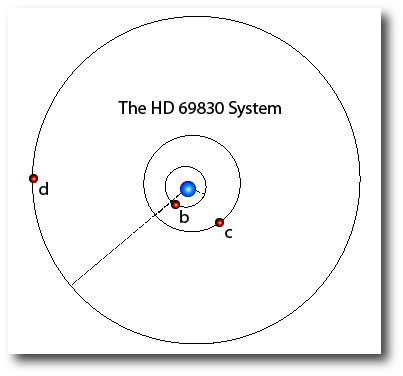The published census of extrasolar planets grew by 1.57% today, with the Geneva Extrasolar Planet Search Teams’s announcement in the journal Nature that trois Neptunes orbit the nearby sunlike star HD 69830.

There are a number of reasons why the Swiss team’s paper is interesting. The HD 69830 system seems tailor-made for a detailed dissection with the Systemic Console. This dissection can get the oklo user-base up and running with the new beta version of the Systemic Backend. In addition, the configuration of this system has some fascinating consequences for the theory of planetary formation and evolution. It is definitely worth digging into this story for the next few posts.
First, the nuts and bolts of the announcement. The three planets, named — you guessed it — HD 69830 “b”, “c” and “d”, clock in with Msin(i) estimates of 10.2, 11.8, and 18.1 Earth masses respectively. Assuming that the system is co-planar and is being viewed close to edge-on, this places b and c squarely in the mysterious planetary mass range that falls between the ice giants (e.g. Uranus and Neptune) and the familiar terrestrial planets. Planet d is somewhat more massive, with a net bulk almost exactly equal to that of Neptune. [It’s important to remember that the inclination of any given planetary systems is more likely to be viewed edge-on (i=90 deg) than pole-on (i=0 deg) for the same reason that the Earth has more real-estate within a hundred miles of the equator than within a hundred miles of the poles.]

The published orbits of HD 69830’s planets are, however, distinctly unreminiscent of Uranus and Neptune. HD 69830 b orbits in 8.667 days, c orbits in 31.6 days, and d circles the star once every 197 days. All three have modest eccentricities.
For kicks, here’s a .wav format sound file which turns the reflex radial velocity waveform from the star into an audio signal. [Note: you can use the downloadable version of the Systemic Console to produce an audio representation of any planetary system, see this post from last week for the details.] In the sample file for HD 69830, I’ve pitched the innermost planet to a rather piercing 3 octaves above A 440. The period difference betwen the inner and outer planets leads to ~4.5 octaves of pitch difference. Planet d’s contribution can be heard as a bass drone about 2 octaves below middle C.
Indeed, the “chord” produced by these three new planets sounds terrible. Badly out of tune, to be precise. This immediately tells us that ther are no strong mean-motion resonances in the published configuration of planets. The human ear-brain system is good at on-the-fly calculation of whether the mean-motion resonance arguments are in circulation or libration. For example, this .wav file corresponds to a (synthetic) planetary system that is participating in several mean-motion resonances. When compared to HD 69830, it sounds awfully good.
As soon as I saw those periods — 8.667 days, 31 days, 197 days — I raced ahead through the paper draft to see if a photometric check for transits was carried out already by the discovery team… Excellent! There’s no mention anywhere in the paper of an attempt at a photometric search for transits of the planets. This will lend a challenging, high-profile opportunity to transitsearch.org. My guess is that the Geneva team was quite eager to get these three worlds out the door, and did not want to hold up the show with an exhaustive photometric check. There’s a real danger that you’ll wind up getting scooped if you cross all your photometric T’s before publishing your radial velocity-detected planets.
In the next post, we’ll look at what the radial velocities have to say.

That is awesome! It pangs me that we don’t have the technology to view these worlds just a little bit closer (in other words, to see if they have moons or not).
And it doesn’t even seem that far away…space wise (about 41 light years).
Hopefully in the next generation (or two) we can develop faster-than-light travel and be able to colonize worlds on multiple star systems.
I agree with Greg… the Lovis, et al. paper is good, but leaves many interesting questions unaddressed. Many of these can be studied with the systemic console (although I haven’t yet tried myself), such as:
Can the presence or absence of 4-body effects in the RV data restrict the inclination of a co-planar system at HD69830? While Lovis, et al. check that the system is dynamically stable, even for low (face-on) inclinations, I don’t know if they check the effect of inclination on the RV data. They only used purely Keplerian fits (i.e. not allowing for mutual interactions between the planets) and perhaps they already know that 4-body effects would not be detectable in this data… just detecting the planets required extra high precision. Even so, we can ask: when would 4-body effects be detectable? Note that this question depends strongly on the inclination of the system (since the inclination determines the true masses of the planets, which determines how strong their mutual graviational interactions are).
These planets have low, but non-zero eccentricities (all about 0.1). I study dynamics and when systems have eccentricities, they almost always have mutual inclinations as well. Trying to determine the mutual inclinations of this system may be unreasonable, but it would be interesting to limit the possibilities. This would be very interesting for GJ 876, as well, although I haven’t seen anyone give a non-co-planar analysis of this system.
Greg didn’t mention in the post that this star has been seen to have an infrared excess consistent with a (bright) asteroid belt… the spectrum looks just like comet Hale-Bopp! (C. Beichman, 2005) The Geneva team did do an analysis to see where an asteroid-like belt would be stable in the edge-on system, and finds some locations that are roughly consistent. This should also be done for other inclinations.
Finally, the possiblity of transits (detectable as early as next week!) is also exciting. Checking on http://www.transitsearch.org, we find that the transit depth of these small objects would be hard to get with a small telescope, even though this is a bright obejct.
That’s enough from me. A very interesting new system to be studied with the console and otherwise.
Darin Ragozzine
Graduate Student in Planetary Science
California Institute of Technology
Pingback: systemic - 20 centimeters per second
In reading the paper more closely, I noticed this caption to Table 1:
“We checked that planet-planet interactions do not significantly influence the orbital parameters by also performing N-body fits to the data with various inclination angles. As expected, dynamical interactions are so weak that they can be neglected over the short time span of the data, and we therefore use the three-keplerian fit in this paper.”
I’m not surprised that 4-body effects are too small to see in this system. Even detecting the planets is near marginal… second-order effects on top of this are even more difficult.
So, apparently, they did check for 4-body interactions. I don’t know why this wasn’t important enough to mention in the main text of the paper, but it still begs the question: how were these n-body fits performed? Are they like the self-consistent fits of the systemic console or did they start with their published solution and then add various inclinations?
Pingback: systemic - Roll ‘em out…
Pingback: systemic - Worlds worlds worlds